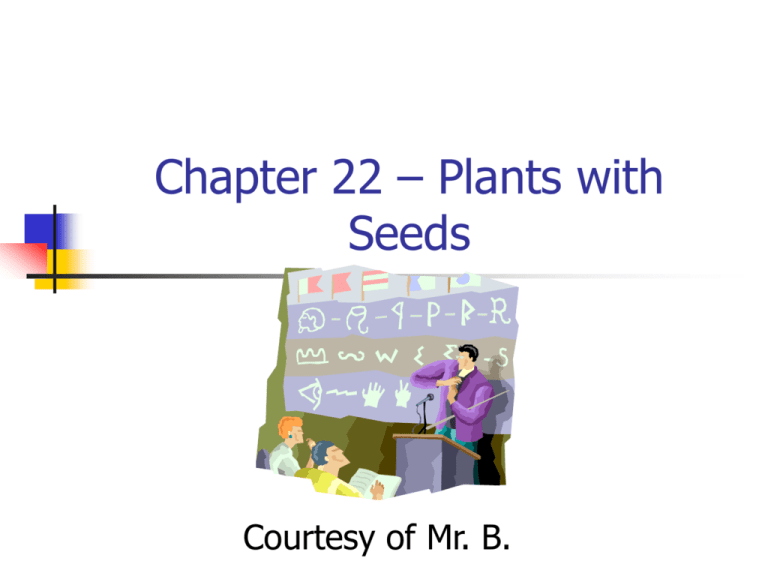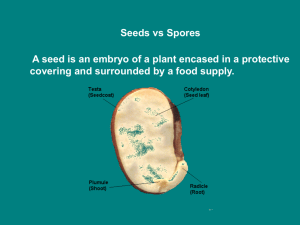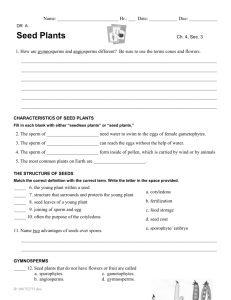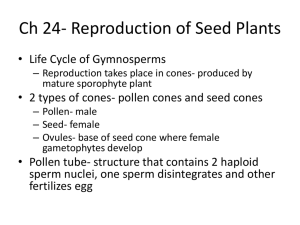Plants with Seeds
advertisement

Chapter 22 – Plants with Seeds Courtesy of Mr. B. GYMNOSPERMS: Non-Flowering Seed Producers Transition from Ferns to Land Plants Medullosa – the seed fern Gymnosperms began to dominate landscapes as climates becam drier at the end of the Paleozoic era 245 mya Gymnosperms appear in the fossil record much earlier than flowering plants, and they: 1. Lack enclosed chambers in which seeds develop. 2. Are grouped into four divisions: 3. Cycadophyta, Ginkgophyta, Gnetophyta and Coniferophyta. GYMNOSPERMS: Plants with seeds that are not enclosed within a fruit, derive their name from the Greek words gymnos (naked) and sperma (seed). In this plant group, the seeds are produced on the open surface of a scale. Unlike flowering plants, the gymnosperms do not form true flowers or fruits. There are four divisions of gymnosperms. Examples of gymnosperms include cycads, ginkgo, conifers and gnetops. Kingdom Plantae - Plants Subkingdom Tracheobionta -- Vascular plants Superdivision Spermatophyta - Seed plants Division Cycadophyta - Cycads Class Cycadopsida Order Cycadales Family Cycadaceae Genus Cycas- cycads Evolutionary advancements of Gymnosperms over the ferns and allies: 1. Seeds 2. Lack of dependence on water for fertilization (air-borne pollen) 3. Progressively more dominant sporophyte 4. Life Cycle a. 5. In the gymnosperms and the flowering plants, the sporophyte generation is dominant with the gametophyte contained in and dependent on the sporophyte. Vascular System a. They do have a well-developed vascular system of xylem and phloem and have true roots, stems, and leaves. b. The vascular tissues are significantly more efficient and effective than the vascular systems of the seedless plants such as the ferns. c. Gymnosperms are usually woody plants. The xylem form the wood if a tree and the phloem tissues are part of the bark (along with cork). The formation of wood from secondary growth is the reason that some sporophytes can reach such large sizes. Cycadophyta Class Cycadopsida Order Cycadales Cycadaceae Cycas sp. The Cycad – a fernlike gymnosperm. Note the cone, or strobilus The Gymnosperms Male cones of Pinus nigra •Unlike the seedless vascular plants, conifers are more prevalent in cooler regions and in desert habitats. • leaf curled to reduce water loss • evolved cold hardiness Female cones of Pinus nigra The Gymnosperms Gnetophyta With angiosperm-like broad leaves, but still retaining cones, the Gnetophytes are another very close link to the Angiosperms Ephedra viridis Female cones More Gnetophytes! All bear cones, with naked seeds, which is an adaptation over the ferns, that produced spores Welwitschia mirabilis growing in the desert Ginkgophyta Ginkgo biloba The link between gymnosperms and angiosperms (note the fleshy seed) Monocot vs. Dicot Seeds Corn Bean Seed coat Stored food (Endosperm) Embryo plant Monocot Seeds Monocot seeds have: Endosperm seed coat endosperm cotyledon coleoptile One cotyledon radicle Dicot Seeds Dicot seeds have: No endosperm at maturity Two cotyledons Seed coat First leaves Early root Cotyledon Organization of primary tissues in a young dicot stem (eg. Bean) The primary tissues of a young monocot stem (eg. Corn) Primary tissues of a young dicot root Cross-section through a monocot root Development of Seeds Function of seed structures: Endosperm Nutrition for embryo Endosperm Cotyledon(s) Cotyledons Nutrition for embryo Overall, what is the function of a seed? Protects young embryo Provides nutrition for the developing embryo Allows dispersal of the embryo over time & space Seed to Seedling Angiosperms Replaced Gymnosperms as the dominant plant type during the Cretaceous Period 60 million years ago Produce flowers, fruits, and seeds Flower Morphology General Angiosperm Life Cycle Pollination Pollination can occur through biotic and abiotic means (wind, water, birds, insects, etc…) Morphological characteristics of flowers attract specific pollinators Insects – the Great Pollinators Conventional spectrum What bees see Bats as Pollinators Fruits Fruit. Mature ovary of the a flower that protects dormant seeds and aids their dispersal Seeds are the product of pollination Seeds are located within fruits There are many different types of fruits Fruit Types Seed Dispersal Seeds are highly adapted to dispersal Examples of morphological characteristics would be buoyancy in fruits (coconut) and “wings” (maple seeds) While others are simply blowing in the wind…. Some seeds are dispersed as a result of being eaten and mingling with feces….









